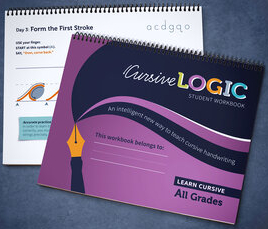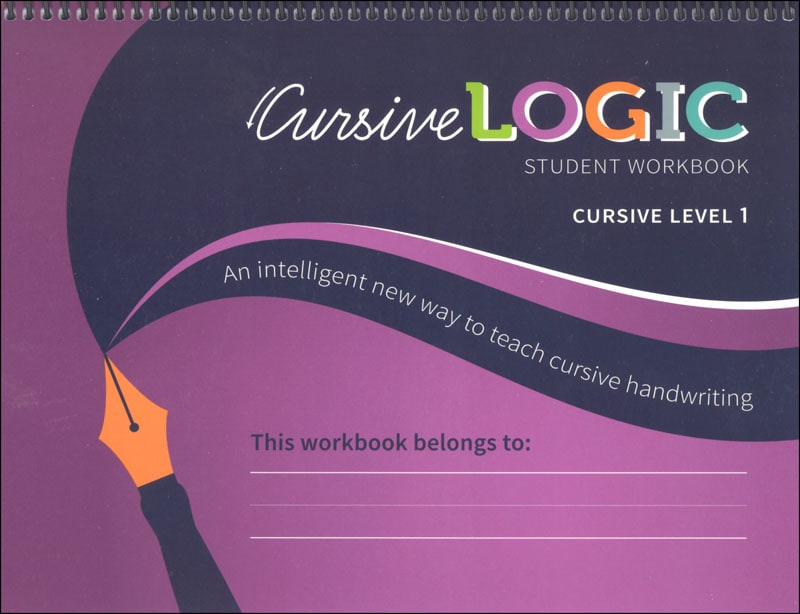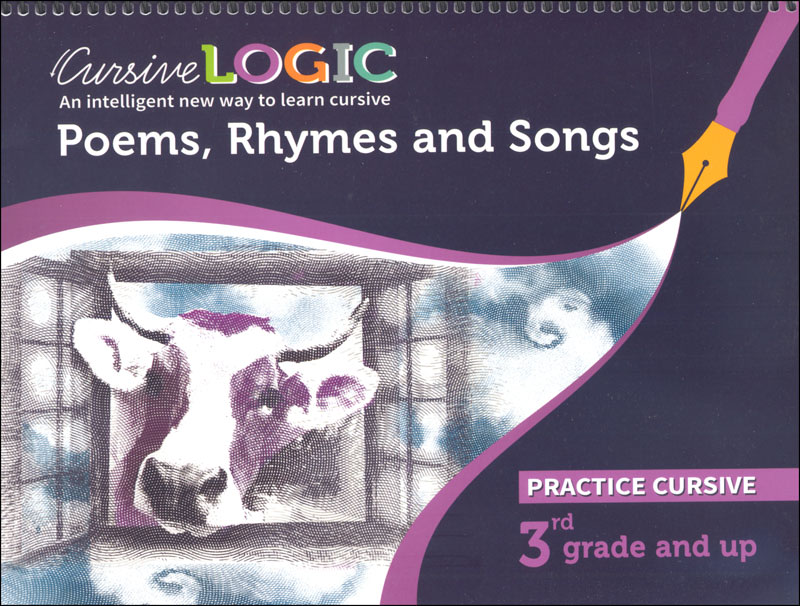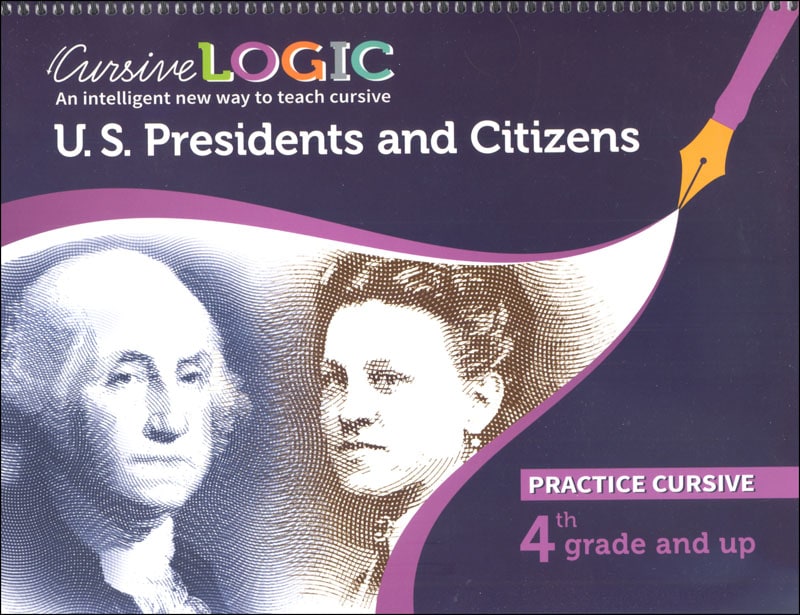CursiveLogic: Student Workbook simplifies the task of learning lower-case cursive forms by teaching all of the forms within four groups which author Linda Shrewsbury identifies with terms such as "ovals." These four categories identify the beginning strokes of the letters. For example, the ovals group includes the letters a, c, d, g, q, and o. Students first practice the initial stroke then they practice the second stroke and completion for each of these letters. Next, they join all of the strokes to form a continuous chain of letters. By teaching groups of letters together, CursiveLogic simplifies the challenge of learning cursive by having common forms reinforce one another. Children no longer need to learn letters individually. (The program assumes that students have already learned how to print all of the letters, and it builds on that foundational knowledge.)
Students ages nine and above can probably learn each group of letters in as little as one hour-long session. Younger students can tackle the lessons in smaller segments, probably spending up to one or two weeks on each group.
Each group’s lessons include instruction on how to join letters that end at the midline rather than the bottom line. When you teach the second group of letters, some practice exercises use real words made of letters from both the first and second groups. Similarly, groups three and four teach their groups of letters, then incorporate words with letters from the previous groups.
Lessons often include tracing exercises, and many of the words to be traced are printed with double lines (like outlines) that will be filled in as the student traces. (Most programs use dotted lines for students to trace.) Tracing exercises are generally followed by practice writing without the tracing forms.
Students will complete lessons directly in the book. If you need lined paper for extra practice, four printable pages on the publisher's website have lines with gradually reduced spacing.
Each group of letters is color-coded to help students readily recall the initial strokes. Students might use colored pencils or pens that match the coding when they learn each string of letters. However, when they trace and write words that combine letters from different groups, they should not stop and switch writing instruments in the middle of a word to match the color coding. They need to use just one color since it is more important that they learn to write each word continuously at this stage.
Upper-case letters don’t fall into neat categories. Still, Shrewsbury divides them into six groups based on starting points and beginning strokes, although the sixth category, consisting of D, L, and Z, is labeled miscellaneous since these letters don’t conform to any of the other five groups. Even though upper-case letters are grouped, they are taught individually rather than in strings of connected letters. Lessons for each group emphasize common beginning strokes when applicable. After students have learned both lower and upper-case forms, they practice copying famous quotations.
A single book includes both teacher and student information. Shrewsbury includes a very helpful introduction to the first lesson, “Getting Started with CursiveLogic.” Here, she discusses correct posture, paper slant for both right- and left-handed writers, and pencil grip, and she provides a beginning exercise that helps students move their hand and arm in a relaxed fashion.
Brief instructions are included on the lesson pages. Students need close supervision when they learn the forms for each group, although they can practice on their own after that.
Practice Workbooks
Students can continue to practice with CursiveLogic: Poems, Rhymes and Songs which is labeled for grades three and up.." After a brief review of both lower- and upper-case letters, it continues with tracing and copywork practice. CursiveLogic: United States Presidents and Citizens is labeled for fourth grade and up. This book has minimal review, although it highlights practice with tricky mid-line connections. Students trace and copy the names of states and their capitals plus quotes from presidents or famous Americans. Students in fifth grade and up can practice with CursiveLogic: Speeches and Writings in American History as they copy writings by a diverse group of authors, such as Patrick Henry, Geronimo, Susan B. Anthhony, Rosa Parks, Cesar Chavez, Sojourner Truth, and John F. Kennedy.
The Art of Cursive
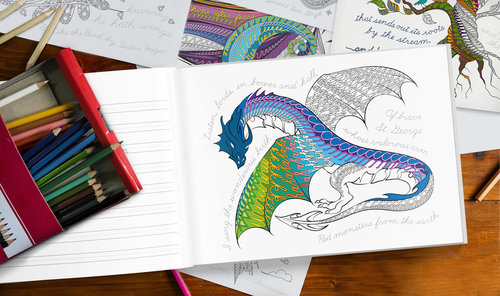 The Art of Cursive is billed as an adult coloring book, but it's so much more than that... and it's not just for adults. The beginning of the book briefly teaches the lower-case cursive forms within the same four groups used in the Cursive Logic books. Then it presents pages for tracing and copywork faced by delightfully whimsical coloring pages. However, these coloring pages aren't just for play. Instead, they have images created with lines of cursive letters or words that can be used for cursive practice. Lines curve and twist as needed within the images.
The Art of Cursive is billed as an adult coloring book, but it's so much more than that... and it's not just for adults. The beginning of the book briefly teaches the lower-case cursive forms within the same four groups used in the Cursive Logic books. Then it presents pages for tracing and copywork faced by delightfully whimsical coloring pages. However, these coloring pages aren't just for play. Instead, they have images created with lines of cursive letters or words that can be used for cursive practice. Lines curve and twist as needed within the images.
Lower-case letters are used within the images. Besides "coloring" the images, students will need to also complete the tracing and copywork activities on other pages to practice upper-case letters. Tracing and copywork pages feature quotes from famous people.
For children who love art, I recommend starting with Cursive Logic then shifting to The Art of Cursive for additional practice. They will need to use fine-colored markers, colored pencils, gel pens, or something similar that gives them access to many colors with which to write.
The Art of Cursive seems like a great fit for those pursuing a Charlotte Mason approach to education because of that approach's appreciation of beauty and language incorporated with art.
Summary
I appreciate the efficiency of CursiveLogic. Students learn all of the basic skills in one book, then can practice as much as needed with the others. While this approach should be especially helpful for older students, it should work well for students of all ages.





